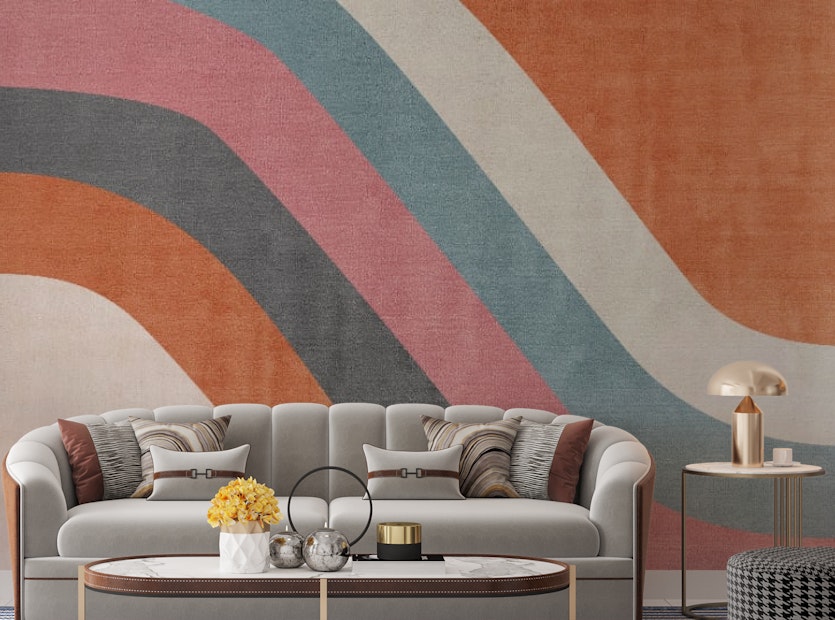Minimalist interior design, known for its simplicity and focus on clean lines, has gained immense popularity for its calm and organized aesthetics. However, this simplicity can sometimes feel stark or cold, where adding an artistic touch through abstract wallpaper becomes a game-changer. Abstract wallpaper, whether art, geometric, watercolour, or even ombre, brings depth, texture, and vibrancy to minimalist spaces, elevating them from bland to beautifully balanced.
This blog will explore how abstract wallpaper can transform minimalist interiors into stylish and personalized sanctuaries, using various abstract designs such as geometric patterns and watercolour motifs. Whether you’re considering enhancing your living room, bedroom, or bathroom with art-inspired wallpaper, this guide will help you make the right choice.
1. The Role of Abstract Wallpaper in Minimalist Design
Minimalist spaces often emphasize negative space, neutral colour palettes, and bare walls to evoke a sense of tranquillity and openness. While this aesthetic has appeal, it can also lead to a lack of personality or warmth in the space. Abstract wallpaper can bridge this gap by adding subtle, artistic expressions without overwhelming the minimalist design principles.
The use of art wallpaper in a minimalist setting introduces a focal point that can be soothing or energizing, depending on the design. Abstract patterns, especially those in muted tones, can add layers of visual interest while maintaining the calmness associated with minimalist interiors.
2. Choosing the Right Abstract Wallpaper for Minimalist Spaces
The key to successfully integrating abstract wallpaper in minimalist design is balance. The wallpaper should complement the existing decor, not compete with it. Below are some types of abstract wallpapers that can seamlessly blend into minimalist spaces:
Geometric Wallpaper
Geometric patterns are inherently structured, making them a natural fit for minimalist interiors. The clean, repeating patterns of geometric wallpaper add a modern edge to any room without disrupting the minimal aesthetic. These designs can range from simple lines and grids to more complex, angular shapes that create an optical illusion of depth.
In a minimalist living room or bedroom, geometric wallpaper can act as an accent wall, drawing attention to a specific room area while understating the rest of the space. Choose soft, neutral tones like beige, grey, or muted blues for a cohesive look, or go bold with black-and-white patterns to make a striking statement.
Watercolor Wallpaper
If you prefer a more fluid and organic look, watercolour wallpaper is a fantastic choice for adding softness and movement to minimalist interiors. The delicate blending of colours in watercolour designs can bring warmth and texture to an otherwise stark space. It works exceptionally well in bedrooms or living areas where you want to evoke a sense of calm and serenity.
The beauty of watercolour wallpaper lies in its versatility—depending on the colour palette, it can be a subtle backdrop or a bold artistic statement. Lighter hues like soft pastels or pale blues are ideal for minimalist homes, creating a serene and harmonious atmosphere.
Ombre Wallpaper
Ombre wallpaper features a gradient of colours that transition smoothly from one shade to another, creating a sophisticated and elegant effect. This wallpaper style is perfect for adding dimension to minimalist spaces without overwhelming them. The gentle fade from light to dark hues in ombre wallpaper can add a soft pop of colour while maintaining the sleekness of minimalist design.
Ombre wallpaper works particularly well in small rooms or spaces like hallways and bathrooms, making the area feel more expansive. Its gradual colour shift can also enhance the sense of light and space, making it a subtle but impactful addition to a minimalist room.
3. Abstract Wallpaper in Bathrooms: A Refreshing Twist
Minimalist bathrooms often rely on clean tiles and white or neutral palettes, sometimes resulting in a sterile or uninspiring look. Incorporating bathroom wallpaper with abstract designs is an innovative way to bring life and interest to this often-overlooked space.
Abstract wallpaper can transform a minimalist bathroom into a chic, spa-like retreat, especially in geometric or watercolour patterns. For instance, geometric wallpaper in soft tones can add a sense of modernity and order, while watercolour wallpaper can introduce a soothing, flowing vibe. Additionally, ombre wallpaper with a gradient from white to a soft pastel hue can give the bathroom a fresh, airy feel.
When choosing wallpaper for a bathroom, opt for moisture-resistant materials to ensure longevity and durability.
4. The Impact of Color and Texture
While minimalist spaces typically favour neutral tones, abstract wallpaper introduces subtle colour without breaking the minimalist aesthetic. The texture provided by different wallpaper styles—whether the structured lines of geometric wallpaper or the fluidity of watercolour designs—brings a tactile quality to the room.
A well-chosen art wallpaper can also make a room feel larger or cozier, depending on its design and placement. For instance, light-coloured watercolour wallpaper with flowing lines can create an illusion of openness, making a small space more expansive. On the other hand, darker tones and bold geometric patterns can provide a sense of intimacy and coziness in larger rooms.
5. Final Thoughts: Elevate Minimalism with Abstract Wallpaper
Abstract wallpaper is an excellent way to bring character and dimension to minimalist interiors without compromising the clean and uncluttered aesthetic. Whether you choose the structured elegance of geometric wallpaper, the gentle fluidity of watercolour wallpaper, or the soft gradients of ombre wallpaper, abstract designs offer a sophisticated way to enhance the beauty of minimalist spaces.
When selecting wallpaper, consider the room’s function, existing colour palette, and the mood you want to evoke. Whether you’re updating a living room, bedroom, or bathroom, abstract wallpaper can add depth, texture, and visual interest while maintaining the tranquil simplicity that makes minimalist design so appealing.






Comments